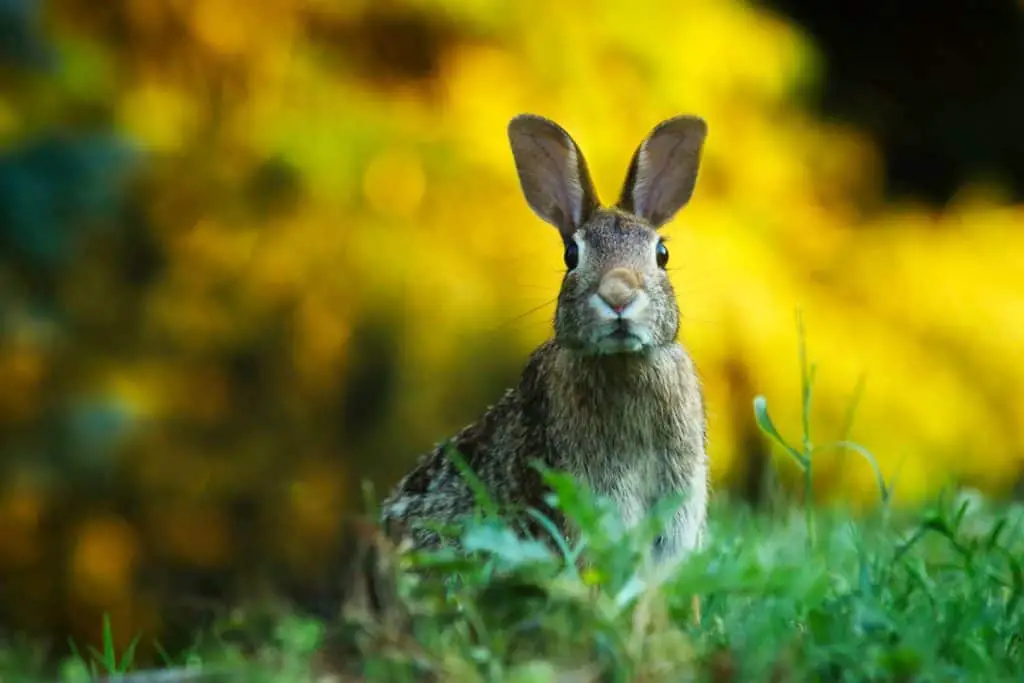Disclosure: We may earn money or products from the companies mentioned in this post.
We usually tackle domestic pet rabbits in our articles, but today, our team would like to take you on a short but important detour; we’re going to talk about how endangered wild rabbits are becoming.
You see, while we were researching for an article about the rarest pet rabbit breeds we learned a lot about the threat of extinction facing wild rabbits.
Rabbits are notorious for being able to reproduce their kind often and in many numbers. After all, everyone knows what the sentence “mating like rabbits” means. Female wild rabbits can have three to seven kittens in a litter and they also have the stamina to reproduce every five to six weeks usually from February to August.
However, According to the International Union for the Conservation of Nature (IUCN) rabbits are considered the most endangered species of mammals on earth.
Today 22 out of 63 species of wild rabbits are considered critically endangered or threatened to be extinct.
There are islands today that are bereft of rabbits’ presence where before they were teeming with them.
Multiple factors contribute to the dire situation of the wild rabbit. This could include a combination of any of the following:
- Loss of Habitat
- Uncontrolled hunting
- Eradication (due to rabbits being known as a farmer’s enemy)
- Virus and diseases such as (Myxomatosis and Rabbit Hemorrhagic disease)
- Decrease in popularity (domesticated breeds)
- Irresponsible ownership

Rare Wild Rabbit Breeds On The Brink Of Extinction
There are rabbits outside of the United States that are also considered to be at the brink of extinction and would also need conservation efforts to keep them from disappearing. Some of these rabbit breeds include the Riverine Rabbit, the Amami Rabbit, and the Annamite Rabbit.
Riverine Rabbit
The Riverine Rabbit is a rabbit breed that can only thrive in very specific habitat conditions. These rabbits live in the dense bushes alongside the seasonal rivers of the Karoo Desert in South Africa. It has been included in the endangered list of species of the International Union for the Conservation of Nature (IUCN) since 1981.
Since then, it has lost most of its habitats to farmlands. At one point, less than 250 individual rabbits of this species survived. Aside from habitat loss, the population of this rabbit breed also declined because they reproduce less often than other rabbits. The Riverine Rabbit can only produce one offspring per year. It is also called “the bushman rabbit” or “the bushman hare”.
The Riverine rabbit can reach 52 cm in size and has very large ears. They look like domesticated rabbits albeit their bodies tend to be longer. It also has a black stripe that runs from the corner of the mouth to its cheek. It has white bands circling its eyes. It has a soft and silky coat usually in the color of white, brown, or grey. This rabbit breed can weigh from 3.3 lbs. to 4lbs when fully grown.
One of the conservation efforts for the preservation of the Riverine Rabbit breed is the Riverine Rabbit Program established by the Endangered Wildlife Trust. This program’s main aim is to preserve and increase the Riverine Rabbit population through the collaboration of landowners and conservation authorities towards its habitat.
It is good news that new populations of the Riverine Rabbit were recently discovered in the Vaal Kloof Private Nature Reserve and the Sanbona Wildlife Reserve.
Amami Rabbit
The Amami Rabbit is a breed of rabbit that also goes by the name of “Ryukyu Rabbits”. This breed of rabbits has Asian roots. They can only be found in the Amami and Tokuna Islands of the Nansei Archipelago. These islands have separated from the main body of Japan a million years ago.
Amami rabbits live in thickly forested lands that are near bodies of water. Deforestation continuously threatens the population of this breed.
Amami Rabbits have long bodies covered with long dark brown fur. It can weigh from 4.4 to 6.6 lbs. when fully grown. Its body length is approximately 16.5 to 20 inches and its tail length can reach from 0.4 to 1.4 inches. Amami has a pointed nose, short ears, and small eyes. It is different from other rabbit breeds in that it can communicate via clicking sounds and noises.
There are estimated to be less than 5,000 Amami rabbits surviving today. To save and grow their population, Japan granted legal protection to this species in 1921. Today, the Amamigunto National Park has conservation efforts to help preserve not only the Amami Rabbits but also other endangered species such as the Amami Woodcock and the Amami Thrush.
The park has programs to raise environmental awareness and Wildlife Traffic Accident Prevention Campaigns to minimize unnecessary wildlife death brought about by vehicles. This park also houses the headquarters of the Amami Wildlife Center.
Annamite Rabbit
The Annamite Rabbit is a striped elusive rabbit that can only be found in Vietnam. It lives in rainforests and is often found in elevated areas. It appears very similar to their Sumatran Striped Rabbit cousins. It has gray hair with seven dorsal stripes on its head and body. It also has reddish rumps. It has short ears, tails, and limbs.
The population of this species is on the watch list of IUCN because of its loss of habitat due to deforestation and illegal logging. It is currently not listed as threatened or endangered because its elusiveness results in the lack of data for its population.
Studies are still currently conducted to glean more data and information on these solitary and elusive breeds. In a study conducted by the World Wildlife Fund, some information has already been discovered towards better understanding the species. It hopes, however, to inspire its readers to become aware of the impact of human activities in the lives of this rare breed.
Volcano Rabbit
The Volcano Rabbit is one of the smallest species of rabbits that exist and can only be found in the slopes of the four inactive volcanoes of Mexico. It is highly endangered with fewer than 7,000 individuals remaining in the wild.
Volcano rabbits are small; it can only weigh a pound when it is fully grown. It has small, rounded ears and its coat is made up of short furs usually in the color of black and brown.
It is known to be crepuscular meaning it is active during twilight.
This rabbit’s diet depends on a particular grass called Zacaton, which only grows on the slope of the volcanoes. Urbanization has continuously threatened the survival of this species as it prevents the spread and growth of the Zacaton hence, comprising this breed’s food source
Conservation efforts are also underway in a bid to save these endangered species. The volcano rabbit breed has been given protection at both national and international levels to control human use of its habitat to prevent more habitat loss.
Movements to involve the communities surrounding the habitats of this breed are being started to raise awareness about the plight of this species.
_____________________________
Human impact on the environment can no longer be ignored. Our earth is getting hotter, we have cities on the brink of being submerged in oceans if we don’t fix our approach to climate change. This means pushing for more Green Policies and sustainable developments.
However, it is important to note that big changes come from small ones. The best way to affect change is in our homes. To live sustainably mean not only providing a future for our progeny to look forward to but also to all creatures who share the same planet as ours. Do you have any tips for more sustainable living?
